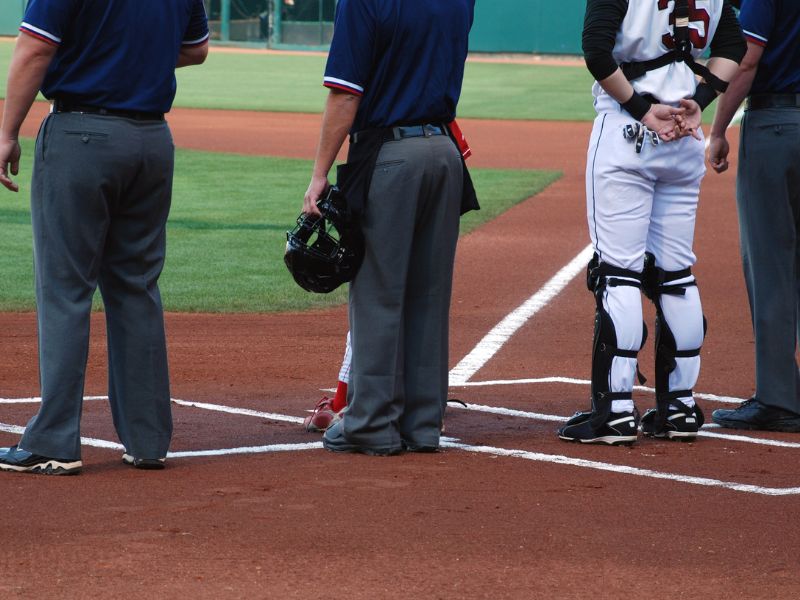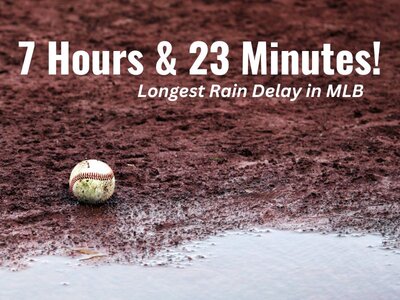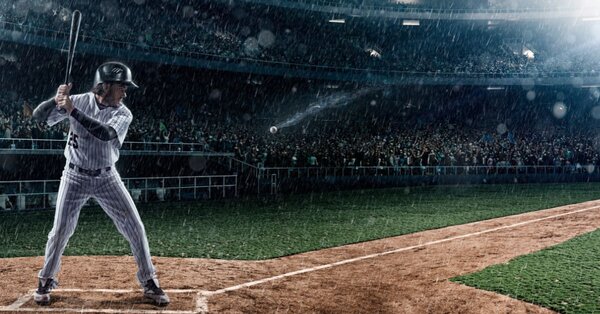In the electrifying atmospheres of the Major League Baseball (MLB) games, the players sometimes have to put their gears on the shelves due to mother nature’s unpredictable strike: rain delays.
It befalls both players and fans so depressively, but there’s no way to continue the action and entertainment once the game is interrupted. Hence, they’re bound to learn how to navigate the games on such occasions.
As a rule of thumb, when rain obstructs an MLB game, the teams, umpires, and of course, the passionate fans must wait for at least 75 minutes before resuming. Meanwhile, the umpires and authorities will discuss to determine whether to cancel the game or reschedule the game on another suitable date.
Still there are many who aren’t aware of the MLB rain delay rules; hence, we’re diving into the intricacies of the standard rules in this informative article.
I’ll share how the weather crises impact the game itself, what measures to be taken for players’ safety, and at the same time, how to strategize the whole situation to maintain competitive edge.
The Unpredictable Nature of Rain Delays
All that preparation by the players and long-awaited enthusiasm of the fans can be debilitated by nature’s pouring beyond measure. Rain delays have negatively impacted many MLB games’ spirit.
The unpredictable nature will come in the way to wash away the anticipation unless you’re enjoying games at MLB stadiums with retractable roofs. Retractable roofs allow the game to continue no matter the weather.
However, these interruptions can vary in length. Some rain delays last for a few minutes, whereas some may drag for hours. Little delays are manageable as it lets the game continue to the end.
Earlier, back in 2020, new MLB rain delay rules were put in place to manage weather interruptions in official games. The rule directed that the interrupted game be played at a later date from the point it was paused.
But lasting delays often cause the game to be canceled or end without any results. That’s why comprehending the rules and procedures surrounding these delays has become an inseparable part of the game.
Umpire Discretion and Game Postponements

As they’re responsible to monitor and control how long a baseball game lasts, umpires also take on to assess the situation and continue accordingly as rain strikes in any baseball game. The same applies to the MLB games as well.
The four umpires decide whether to pause, continue, or postpone the game depending on the spanning of rain delays. For this, they take various factors into account.
Those factors include the amount of rainfall, the field’s condition, and the forecast for the remainder of the game. If it’s pouring heavily, and the umpires find it risky for the players to continue the game on field, they would call it a rain delay.
Both players and fans might be disheartened, but it’s to the umpires’ discretion to put the players’ safety on top. Waterlogged fields may pose a high risk of injuries; hence, the game might be postponed to ensure fair competition.
Intermittent Logistics During Rain Delay

While rain delays may pose a mental challenge to both players and fans, there are some things both groups can avail to sustain their patience before the game resumes.
In some cases, both contender teams may retreat to their respective clubhouses or dugouts. These facilities are usually equipped with amenities to keep players engaged and focused with fielding drills.
Some stadiums even consist of indoor batting cages and workout facilities where players can keep up their preparedness.
As for the fans, it’s a mixed emotional reaction during rain delays. They can be both excited and frustrated. On many such occasions, fans are invited for behind-the-scenes interviews and historical anecdotes.
Besides, there are even options for random contests on the jumbotron for them.
Restarting the Game: Conditions and Strategies
What happens when the rain stops finally?
It all depends on the condition of the field. The umpires come down to the field, inspect it to determine whether it’s still risk-free for the players to resume the game.
The sustainability of the field post rain delay also highly depends on the hard work of the ground crew. They work tirelessly to recover the field from the damage caused by the rain. Their work involves filling in divots or improving drainage to turn the field as playable as possible.
Apart from the reconditioning of the field, players also need to warm up to come back with full focus and energy. For instance, hitters often recalibrate their approach at the plate while pitchers would take extra time to get back their rhythm.
The post rain delay condition often impacts the ball movement, which affects the performance of both hitters and pitchers. That’s what we’ll discuss in the next section.
Rain Delay and Its Impact on Player Performance
In a matter of minutes or hours, rain delay can shift the momentum of the game, especially the individual performance level. Players who might’ve been pumped up during the game, may lose the groom and focus once the rain has splashed the field.
For instance, different types of pitchers may often experience stiffness in their arms after a substantial delay in between the game. This calls for carefulness at their end before resuming the game after rain delay as it may affect their skill.
Conversely, hitters are supposed to adapt to the changed field conditions. Due to the rain effect, it may impact the movement of the ball which they might find hard to hit with full rhythm and force. Moreover, it might alter the trajectory of the ball during fly balls and throws.
In short, the post rain delay field condition will attribute an extra layer of complexity for the players to keep up the spirit of the baseball game.
Crazy Rain Delay Fact: The Longest in MLB History!

Of all the fun facts about baseball, rain delays may be among the top ones. Some rain delays can be long enough to put your patience and resilience to the test. Not for just one hour or two, but for more than seven straight hours!
This monumental rain delay took place on August 12, 1990. It was an MLB game between the Chicago White Sox and the Texas Rangers at Comiskey Park. But alas! It turned into an endurance test due to rain.
As rain started pouring, the authority paused the match in the third inning, little knowing what awaited ahead. They waited for minutes after minutes, and hours after hours, leading to the longest rain delay in MLB history.
Lasting a staggering seven hours and twenty three minutes, players, fans, and officials waited patiently but to no avail. And after a grueling seven-hour patience, all they found was a muddy quagmire for a field.
Imagine the love for the game demonstrated by both players and fans, waiting that long to still see to the end of it. And indeed, the game continued after that longest rain delay in MLB history, imprinting the spirit of the game.
Frequently Asked Questions
1. How many innings must be completed before an official rain delay in an MLB game?
Answer: Rain delays can cancel, suspend, or postpone an MLB game whenever the weather seems downcast and starts pouring down on the field. There’s no indication of a specific number of innings to be completed for calling it an official rain delay.
2. Can fans use their tickets if rain delay cancels the game?
Answer: MLB rainout ticket policies vary in terms of teams or venues involved in a particular game. For instance, Boston Red Sox or New York Yankees offer ticket exchanges for future games if a game is canceled due to rain delay, whereas, Chicago Cubs offers a refund in addition to the ticket exchange policy for rainouts.
3. How long should a rain delay last before deciding about an MLB game’s results?
Answer: It all depends on the intensity of the downpour instead of the longevity of rain delay to decide upon the fate of an MLB game’s fate. The umpires and league officials will inspect the field conditions, logistical arrangements, etc., before concluding something.
However, the official baseball rule 4.12 says that an MLB game must complete at least 4 innings before rain interruption to be called an official game and continue on another day to see results.
4. What is a rain delay game called in MLB?
Answer: A rain delay in a baseball is typically called rainout, washout, or rain stopped delay.
5. How long can a rain delay last in MLB?
Answer: It all depends on the weather condition. It may last for minutes or hours. The longest period a rain delay lasted in the history of MLB is 7 hours and 23 minutes in August 2012.
Bottom Line
It’s a lesson for all baseball players and fans that even big games like Major League Baseball can be disrupted due to the unpredictable nature. No matter how well it was planned, you can’t outsmart nature.
However, these interruptions test the players and fans in terms of patience and adaptability. The MLB rain delay rules there to ensure the safety of the players and the integrity of the game.
So, the next time you go to enjoy a baseball game, don’t get frustrated if the sky opens up and starts pouring down. Rather, appreciate the challenge to spark your spirit for the game.
More Resources
Funniest Moments in Baseball History

Hello everyone. My name is Jason Butler, and I live in California, America. I was a professional AAA Minor League Baseball player. I lost my chance of playing MLB for injury issues, but I did not lose my love for baseball. I attended the coaching training program and am now working as a coach in a small school in San Diego.
I always love to share my experience and knowledge if that can help you. Play baseball, and stay fit.
